BAP62: Fair Value and Historical Cost in Financial Reporting
VerifiedAdded on 2023/06/04
|10
|2719
|455
Essay
AI Summary
This essay provides a comparative analysis of fair value and historical cost accounting methods in financial reporting, using Wesfarmers Limited as a case study. It reviews the literature on both accounting approaches, highlighting their strengths and weaknesses. The essay then examines the application of recognition, measurement, and disclosure criteria for both methods, referencing AASB standards and Wesfarmers' 2017 annual report. The analysis covers revenue, expenses, assets, and liabilities, noting that Wesfarmers integrates both historic and fair value accounting. The essay concludes with recommendations for accounting managers, emphasizing the importance of adhering to AASB standards based on IFRS accounting standards. Desklib provides similar solved assignments and past papers for students.
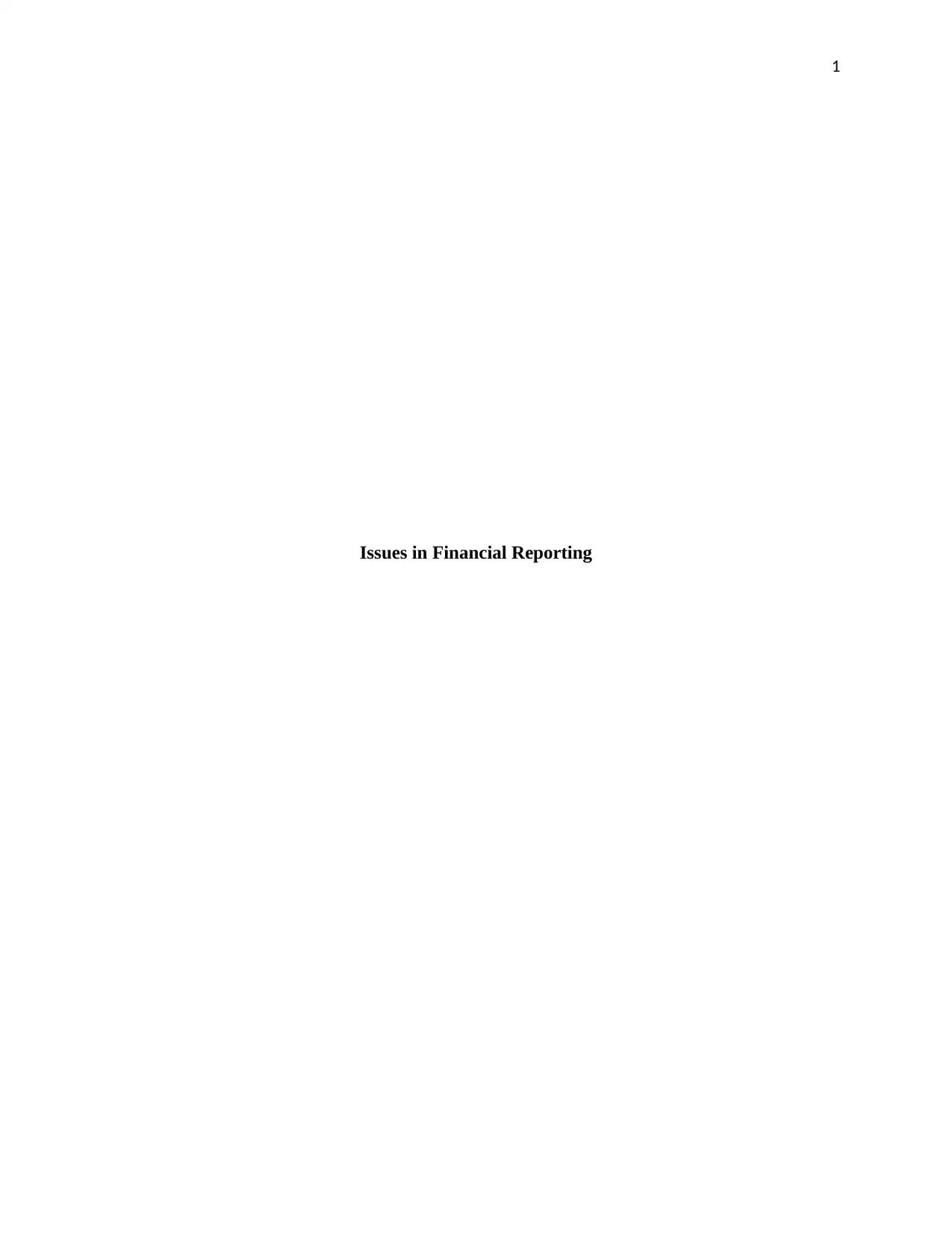
1
Issues in Financial Reporting
Issues in Financial Reporting
Paraphrase This Document
Need a fresh take? Get an instant paraphrase of this document with our AI Paraphraser
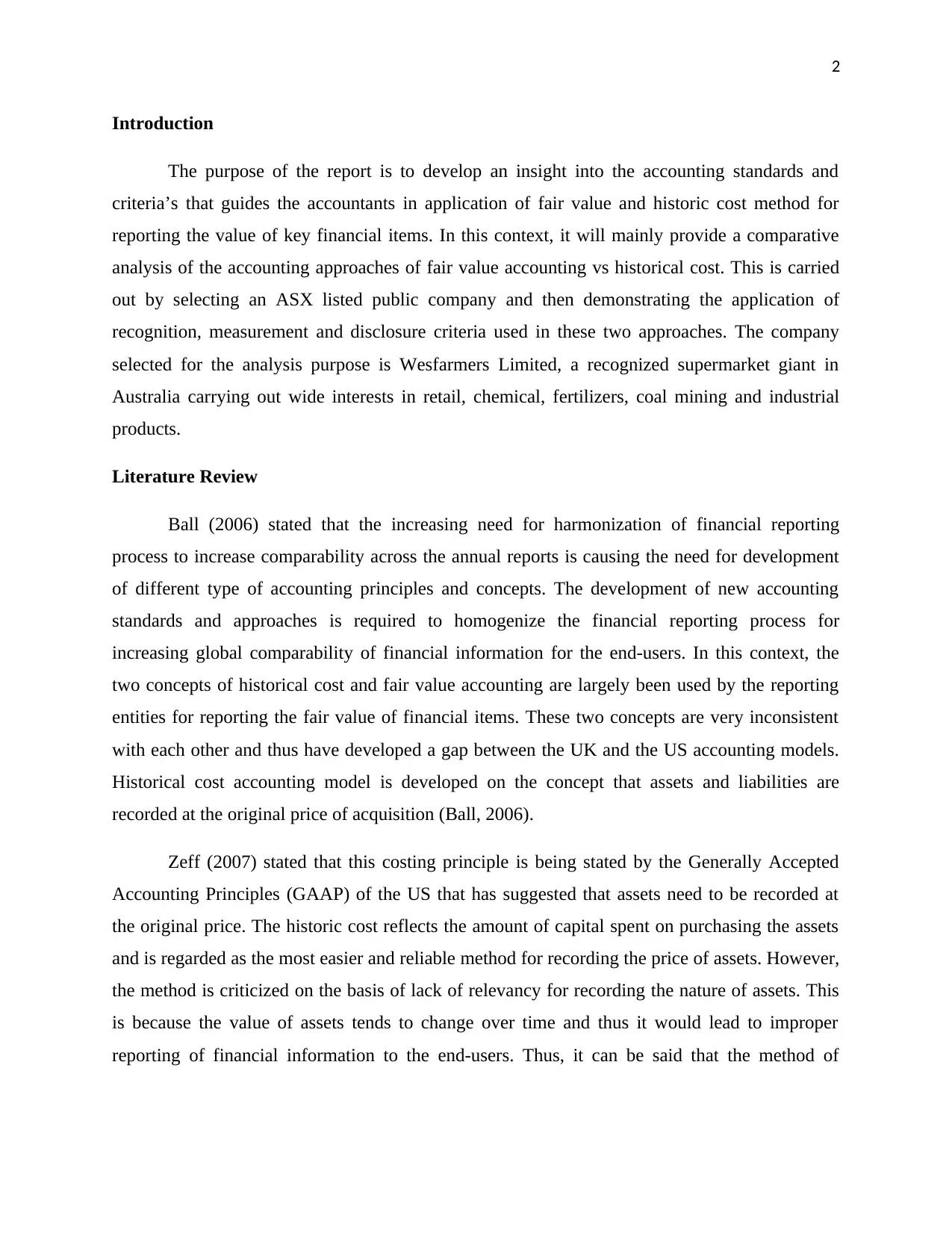
2
Introduction
The purpose of the report is to develop an insight into the accounting standards and
criteria’s that guides the accountants in application of fair value and historic cost method for
reporting the value of key financial items. In this context, it will mainly provide a comparative
analysis of the accounting approaches of fair value accounting vs historical cost. This is carried
out by selecting an ASX listed public company and then demonstrating the application of
recognition, measurement and disclosure criteria used in these two approaches. The company
selected for the analysis purpose is Wesfarmers Limited, a recognized supermarket giant in
Australia carrying out wide interests in retail, chemical, fertilizers, coal mining and industrial
products.
Literature Review
Ball (2006) stated that the increasing need for harmonization of financial reporting
process to increase comparability across the annual reports is causing the need for development
of different type of accounting principles and concepts. The development of new accounting
standards and approaches is required to homogenize the financial reporting process for
increasing global comparability of financial information for the end-users. In this context, the
two concepts of historical cost and fair value accounting are largely been used by the reporting
entities for reporting the fair value of financial items. These two concepts are very inconsistent
with each other and thus have developed a gap between the UK and the US accounting models.
Historical cost accounting model is developed on the concept that assets and liabilities are
recorded at the original price of acquisition (Ball, 2006).
Zeff (2007) stated that this costing principle is being stated by the Generally Accepted
Accounting Principles (GAAP) of the US that has suggested that assets need to be recorded at
the original price. The historic cost reflects the amount of capital spent on purchasing the assets
and is regarded as the most easier and reliable method for recording the price of assets. However,
the method is criticized on the basis of lack of relevancy for recording the nature of assets. This
is because the value of assets tends to change over time and thus it would lead to improper
reporting of financial information to the end-users. Thus, it can be said that the method of
Introduction
The purpose of the report is to develop an insight into the accounting standards and
criteria’s that guides the accountants in application of fair value and historic cost method for
reporting the value of key financial items. In this context, it will mainly provide a comparative
analysis of the accounting approaches of fair value accounting vs historical cost. This is carried
out by selecting an ASX listed public company and then demonstrating the application of
recognition, measurement and disclosure criteria used in these two approaches. The company
selected for the analysis purpose is Wesfarmers Limited, a recognized supermarket giant in
Australia carrying out wide interests in retail, chemical, fertilizers, coal mining and industrial
products.
Literature Review
Ball (2006) stated that the increasing need for harmonization of financial reporting
process to increase comparability across the annual reports is causing the need for development
of different type of accounting principles and concepts. The development of new accounting
standards and approaches is required to homogenize the financial reporting process for
increasing global comparability of financial information for the end-users. In this context, the
two concepts of historical cost and fair value accounting are largely been used by the reporting
entities for reporting the fair value of financial items. These two concepts are very inconsistent
with each other and thus have developed a gap between the UK and the US accounting models.
Historical cost accounting model is developed on the concept that assets and liabilities are
recorded at the original price of acquisition (Ball, 2006).
Zeff (2007) stated that this costing principle is being stated by the Generally Accepted
Accounting Principles (GAAP) of the US that has suggested that assets need to be recorded at
the original price. The historic cost reflects the amount of capital spent on purchasing the assets
and is regarded as the most easier and reliable method for recording the price of assets. However,
the method is criticized on the basis of lack of relevancy for recording the nature of assets. This
is because the value of assets tends to change over time and thus it would lead to improper
reporting of financial information to the end-users. Thus, it can be said that the method of
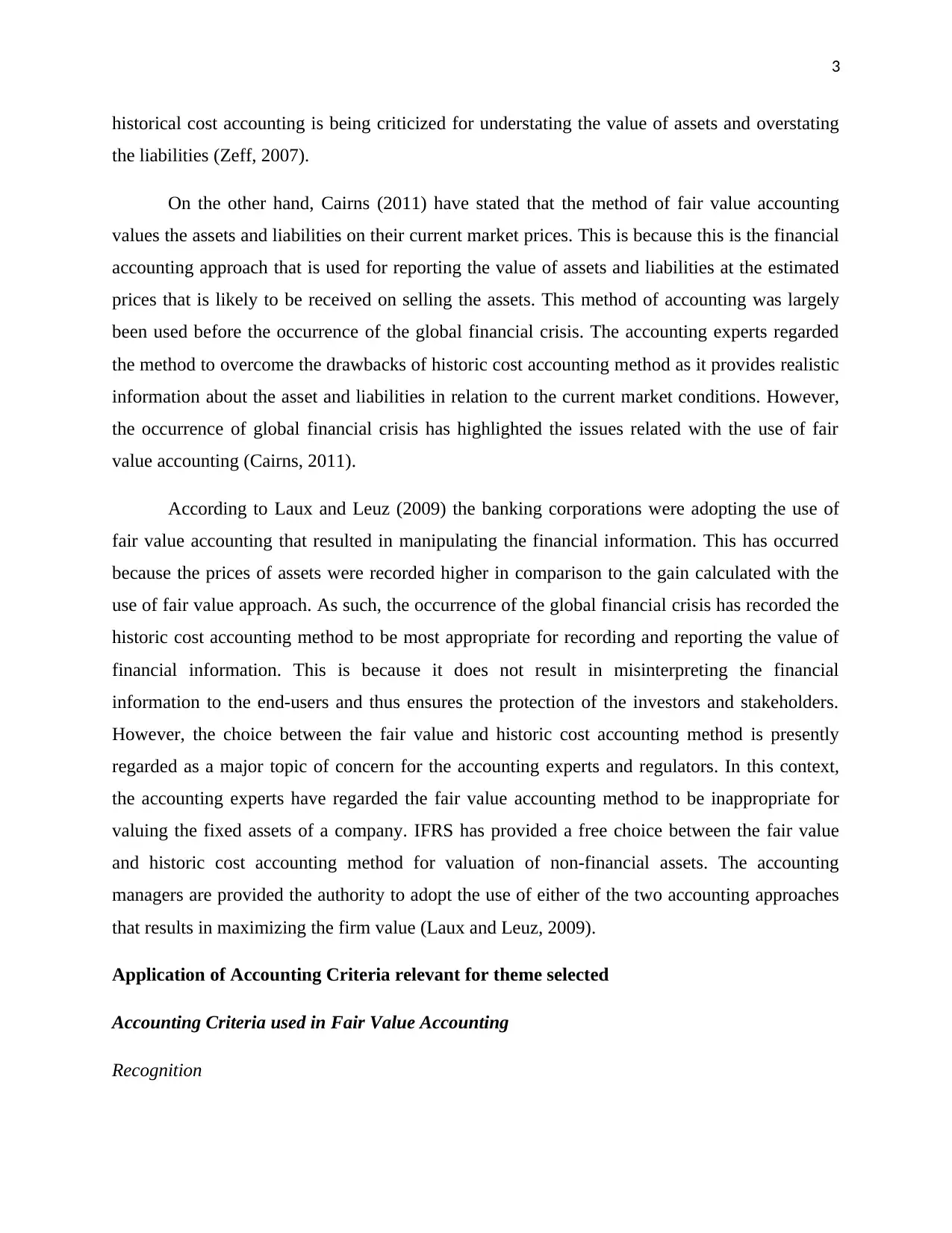
3
historical cost accounting is being criticized for understating the value of assets and overstating
the liabilities (Zeff, 2007).
On the other hand, Cairns (2011) have stated that the method of fair value accounting
values the assets and liabilities on their current market prices. This is because this is the financial
accounting approach that is used for reporting the value of assets and liabilities at the estimated
prices that is likely to be received on selling the assets. This method of accounting was largely
been used before the occurrence of the global financial crisis. The accounting experts regarded
the method to overcome the drawbacks of historic cost accounting method as it provides realistic
information about the asset and liabilities in relation to the current market conditions. However,
the occurrence of global financial crisis has highlighted the issues related with the use of fair
value accounting (Cairns, 2011).
According to Laux and Leuz (2009) the banking corporations were adopting the use of
fair value accounting that resulted in manipulating the financial information. This has occurred
because the prices of assets were recorded higher in comparison to the gain calculated with the
use of fair value approach. As such, the occurrence of the global financial crisis has recorded the
historic cost accounting method to be most appropriate for recording and reporting the value of
financial information. This is because it does not result in misinterpreting the financial
information to the end-users and thus ensures the protection of the investors and stakeholders.
However, the choice between the fair value and historic cost accounting method is presently
regarded as a major topic of concern for the accounting experts and regulators. In this context,
the accounting experts have regarded the fair value accounting method to be inappropriate for
valuing the fixed assets of a company. IFRS has provided a free choice between the fair value
and historic cost accounting method for valuation of non-financial assets. The accounting
managers are provided the authority to adopt the use of either of the two accounting approaches
that results in maximizing the firm value (Laux and Leuz, 2009).
Application of Accounting Criteria relevant for theme selected
Accounting Criteria used in Fair Value Accounting
Recognition
historical cost accounting is being criticized for understating the value of assets and overstating
the liabilities (Zeff, 2007).
On the other hand, Cairns (2011) have stated that the method of fair value accounting
values the assets and liabilities on their current market prices. This is because this is the financial
accounting approach that is used for reporting the value of assets and liabilities at the estimated
prices that is likely to be received on selling the assets. This method of accounting was largely
been used before the occurrence of the global financial crisis. The accounting experts regarded
the method to overcome the drawbacks of historic cost accounting method as it provides realistic
information about the asset and liabilities in relation to the current market conditions. However,
the occurrence of global financial crisis has highlighted the issues related with the use of fair
value accounting (Cairns, 2011).
According to Laux and Leuz (2009) the banking corporations were adopting the use of
fair value accounting that resulted in manipulating the financial information. This has occurred
because the prices of assets were recorded higher in comparison to the gain calculated with the
use of fair value approach. As such, the occurrence of the global financial crisis has recorded the
historic cost accounting method to be most appropriate for recording and reporting the value of
financial information. This is because it does not result in misinterpreting the financial
information to the end-users and thus ensures the protection of the investors and stakeholders.
However, the choice between the fair value and historic cost accounting method is presently
regarded as a major topic of concern for the accounting experts and regulators. In this context,
the accounting experts have regarded the fair value accounting method to be inappropriate for
valuing the fixed assets of a company. IFRS has provided a free choice between the fair value
and historic cost accounting method for valuation of non-financial assets. The accounting
managers are provided the authority to adopt the use of either of the two accounting approaches
that results in maximizing the firm value (Laux and Leuz, 2009).
Application of Accounting Criteria relevant for theme selected
Accounting Criteria used in Fair Value Accounting
Recognition
⊘ This is a preview!⊘
Do you want full access?
Subscribe today to unlock all pages.

Trusted by 1+ million students worldwide
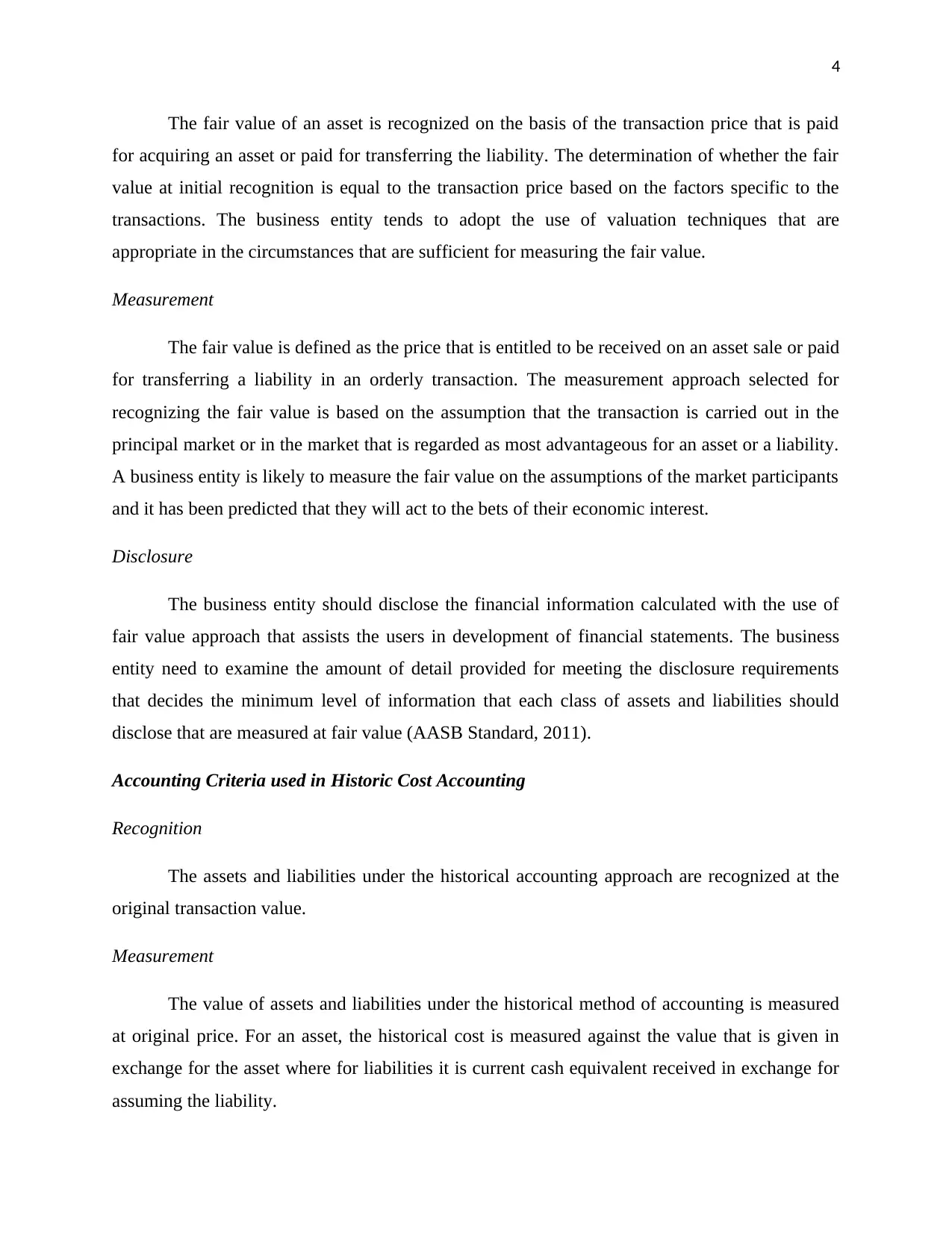
4
The fair value of an asset is recognized on the basis of the transaction price that is paid
for acquiring an asset or paid for transferring the liability. The determination of whether the fair
value at initial recognition is equal to the transaction price based on the factors specific to the
transactions. The business entity tends to adopt the use of valuation techniques that are
appropriate in the circumstances that are sufficient for measuring the fair value.
Measurement
The fair value is defined as the price that is entitled to be received on an asset sale or paid
for transferring a liability in an orderly transaction. The measurement approach selected for
recognizing the fair value is based on the assumption that the transaction is carried out in the
principal market or in the market that is regarded as most advantageous for an asset or a liability.
A business entity is likely to measure the fair value on the assumptions of the market participants
and it has been predicted that they will act to the bets of their economic interest.
Disclosure
The business entity should disclose the financial information calculated with the use of
fair value approach that assists the users in development of financial statements. The business
entity need to examine the amount of detail provided for meeting the disclosure requirements
that decides the minimum level of information that each class of assets and liabilities should
disclose that are measured at fair value (AASB Standard, 2011).
Accounting Criteria used in Historic Cost Accounting
Recognition
The assets and liabilities under the historical accounting approach are recognized at the
original transaction value.
Measurement
The value of assets and liabilities under the historical method of accounting is measured
at original price. For an asset, the historical cost is measured against the value that is given in
exchange for the asset where for liabilities it is current cash equivalent received in exchange for
assuming the liability.
The fair value of an asset is recognized on the basis of the transaction price that is paid
for acquiring an asset or paid for transferring the liability. The determination of whether the fair
value at initial recognition is equal to the transaction price based on the factors specific to the
transactions. The business entity tends to adopt the use of valuation techniques that are
appropriate in the circumstances that are sufficient for measuring the fair value.
Measurement
The fair value is defined as the price that is entitled to be received on an asset sale or paid
for transferring a liability in an orderly transaction. The measurement approach selected for
recognizing the fair value is based on the assumption that the transaction is carried out in the
principal market or in the market that is regarded as most advantageous for an asset or a liability.
A business entity is likely to measure the fair value on the assumptions of the market participants
and it has been predicted that they will act to the bets of their economic interest.
Disclosure
The business entity should disclose the financial information calculated with the use of
fair value approach that assists the users in development of financial statements. The business
entity need to examine the amount of detail provided for meeting the disclosure requirements
that decides the minimum level of information that each class of assets and liabilities should
disclose that are measured at fair value (AASB Standard, 2011).
Accounting Criteria used in Historic Cost Accounting
Recognition
The assets and liabilities under the historical accounting approach are recognized at the
original transaction value.
Measurement
The value of assets and liabilities under the historical method of accounting is measured
at original price. For an asset, the historical cost is measured against the value that is given in
exchange for the asset where for liabilities it is current cash equivalent received in exchange for
assuming the liability.
Paraphrase This Document
Need a fresh take? Get an instant paraphrase of this document with our AI Paraphraser
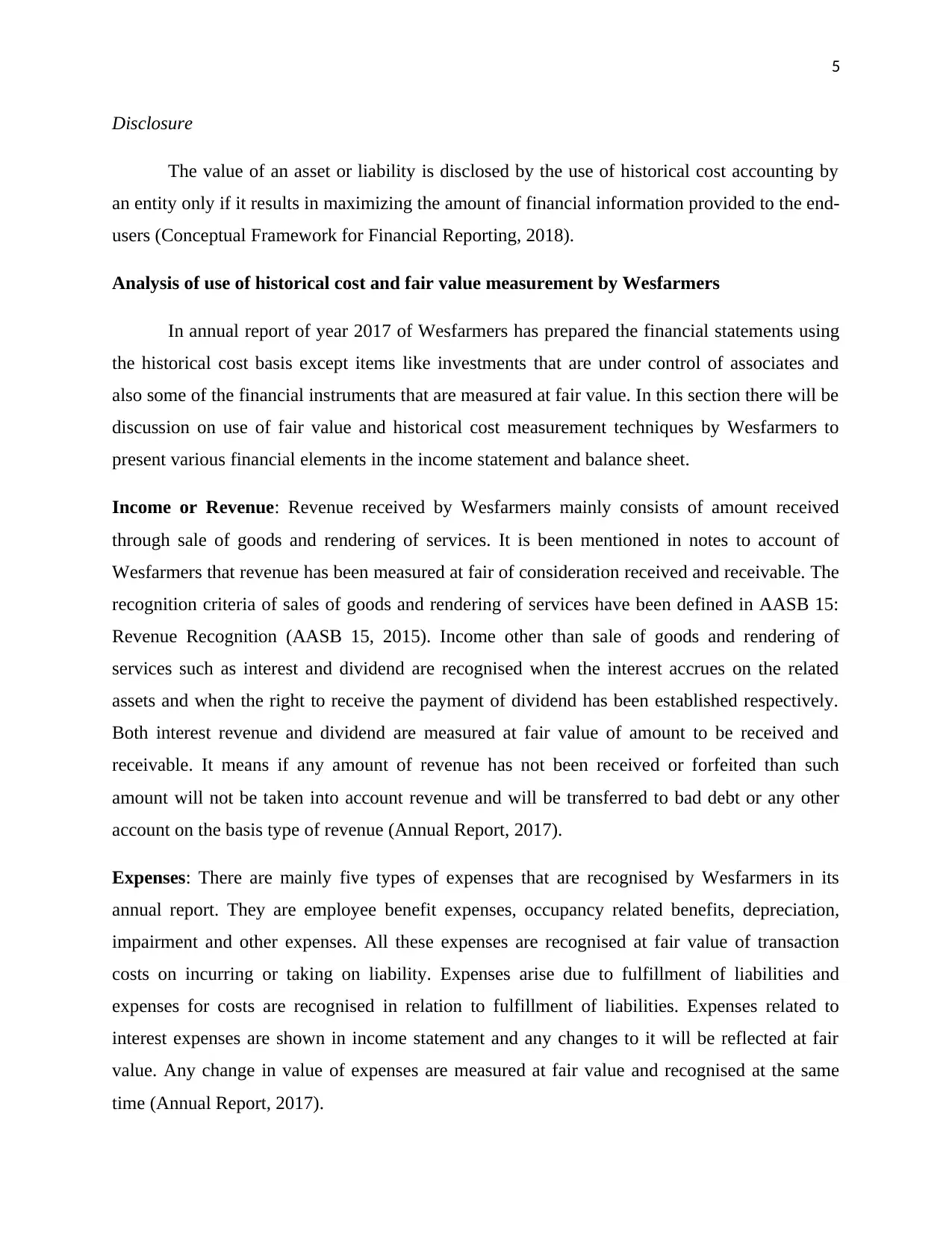
5
Disclosure
The value of an asset or liability is disclosed by the use of historical cost accounting by
an entity only if it results in maximizing the amount of financial information provided to the end-
users (Conceptual Framework for Financial Reporting, 2018).
Analysis of use of historical cost and fair value measurement by Wesfarmers
In annual report of year 2017 of Wesfarmers has prepared the financial statements using
the historical cost basis except items like investments that are under control of associates and
also some of the financial instruments that are measured at fair value. In this section there will be
discussion on use of fair value and historical cost measurement techniques by Wesfarmers to
present various financial elements in the income statement and balance sheet.
Income or Revenue: Revenue received by Wesfarmers mainly consists of amount received
through sale of goods and rendering of services. It is been mentioned in notes to account of
Wesfarmers that revenue has been measured at fair of consideration received and receivable. The
recognition criteria of sales of goods and rendering of services have been defined in AASB 15:
Revenue Recognition (AASB 15, 2015). Income other than sale of goods and rendering of
services such as interest and dividend are recognised when the interest accrues on the related
assets and when the right to receive the payment of dividend has been established respectively.
Both interest revenue and dividend are measured at fair value of amount to be received and
receivable. It means if any amount of revenue has not been received or forfeited than such
amount will not be taken into account revenue and will be transferred to bad debt or any other
account on the basis type of revenue (Annual Report, 2017).
Expenses: There are mainly five types of expenses that are recognised by Wesfarmers in its
annual report. They are employee benefit expenses, occupancy related benefits, depreciation,
impairment and other expenses. All these expenses are recognised at fair value of transaction
costs on incurring or taking on liability. Expenses arise due to fulfillment of liabilities and
expenses for costs are recognised in relation to fulfillment of liabilities. Expenses related to
interest expenses are shown in income statement and any changes to it will be reflected at fair
value. Any change in value of expenses are measured at fair value and recognised at the same
time (Annual Report, 2017).
Disclosure
The value of an asset or liability is disclosed by the use of historical cost accounting by
an entity only if it results in maximizing the amount of financial information provided to the end-
users (Conceptual Framework for Financial Reporting, 2018).
Analysis of use of historical cost and fair value measurement by Wesfarmers
In annual report of year 2017 of Wesfarmers has prepared the financial statements using
the historical cost basis except items like investments that are under control of associates and
also some of the financial instruments that are measured at fair value. In this section there will be
discussion on use of fair value and historical cost measurement techniques by Wesfarmers to
present various financial elements in the income statement and balance sheet.
Income or Revenue: Revenue received by Wesfarmers mainly consists of amount received
through sale of goods and rendering of services. It is been mentioned in notes to account of
Wesfarmers that revenue has been measured at fair of consideration received and receivable. The
recognition criteria of sales of goods and rendering of services have been defined in AASB 15:
Revenue Recognition (AASB 15, 2015). Income other than sale of goods and rendering of
services such as interest and dividend are recognised when the interest accrues on the related
assets and when the right to receive the payment of dividend has been established respectively.
Both interest revenue and dividend are measured at fair value of amount to be received and
receivable. It means if any amount of revenue has not been received or forfeited than such
amount will not be taken into account revenue and will be transferred to bad debt or any other
account on the basis type of revenue (Annual Report, 2017).
Expenses: There are mainly five types of expenses that are recognised by Wesfarmers in its
annual report. They are employee benefit expenses, occupancy related benefits, depreciation,
impairment and other expenses. All these expenses are recognised at fair value of transaction
costs on incurring or taking on liability. Expenses arise due to fulfillment of liabilities and
expenses for costs are recognised in relation to fulfillment of liabilities. Expenses related to
interest expenses are shown in income statement and any changes to it will be reflected at fair
value. Any change in value of expenses are measured at fair value and recognised at the same
time (Annual Report, 2017).
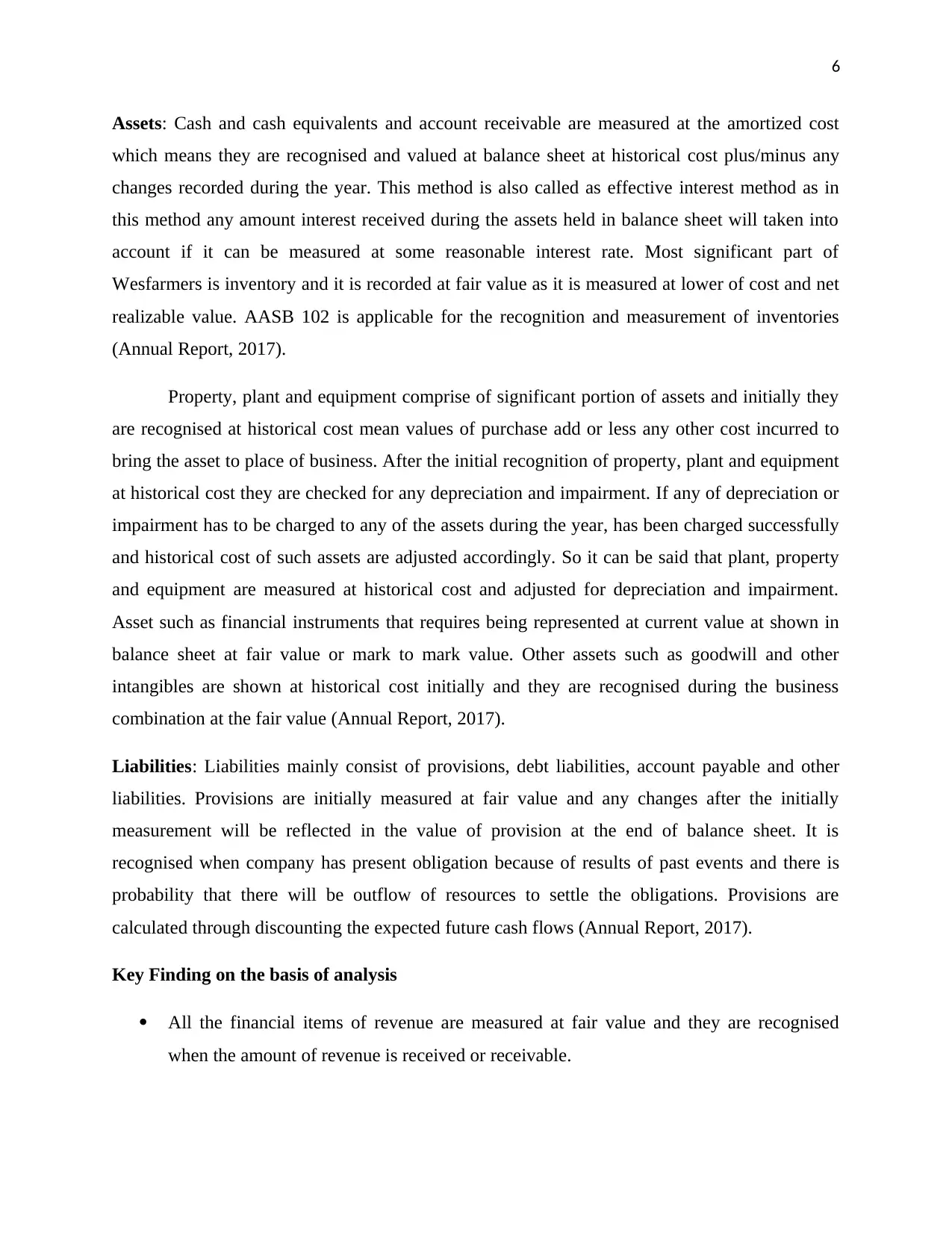
6
Assets: Cash and cash equivalents and account receivable are measured at the amortized cost
which means they are recognised and valued at balance sheet at historical cost plus/minus any
changes recorded during the year. This method is also called as effective interest method as in
this method any amount interest received during the assets held in balance sheet will taken into
account if it can be measured at some reasonable interest rate. Most significant part of
Wesfarmers is inventory and it is recorded at fair value as it is measured at lower of cost and net
realizable value. AASB 102 is applicable for the recognition and measurement of inventories
(Annual Report, 2017).
Property, plant and equipment comprise of significant portion of assets and initially they
are recognised at historical cost mean values of purchase add or less any other cost incurred to
bring the asset to place of business. After the initial recognition of property, plant and equipment
at historical cost they are checked for any depreciation and impairment. If any of depreciation or
impairment has to be charged to any of the assets during the year, has been charged successfully
and historical cost of such assets are adjusted accordingly. So it can be said that plant, property
and equipment are measured at historical cost and adjusted for depreciation and impairment.
Asset such as financial instruments that requires being represented at current value at shown in
balance sheet at fair value or mark to mark value. Other assets such as goodwill and other
intangibles are shown at historical cost initially and they are recognised during the business
combination at the fair value (Annual Report, 2017).
Liabilities: Liabilities mainly consist of provisions, debt liabilities, account payable and other
liabilities. Provisions are initially measured at fair value and any changes after the initially
measurement will be reflected in the value of provision at the end of balance sheet. It is
recognised when company has present obligation because of results of past events and there is
probability that there will be outflow of resources to settle the obligations. Provisions are
calculated through discounting the expected future cash flows (Annual Report, 2017).
Key Finding on the basis of analysis
All the financial items of revenue are measured at fair value and they are recognised
when the amount of revenue is received or receivable.
Assets: Cash and cash equivalents and account receivable are measured at the amortized cost
which means they are recognised and valued at balance sheet at historical cost plus/minus any
changes recorded during the year. This method is also called as effective interest method as in
this method any amount interest received during the assets held in balance sheet will taken into
account if it can be measured at some reasonable interest rate. Most significant part of
Wesfarmers is inventory and it is recorded at fair value as it is measured at lower of cost and net
realizable value. AASB 102 is applicable for the recognition and measurement of inventories
(Annual Report, 2017).
Property, plant and equipment comprise of significant portion of assets and initially they
are recognised at historical cost mean values of purchase add or less any other cost incurred to
bring the asset to place of business. After the initial recognition of property, plant and equipment
at historical cost they are checked for any depreciation and impairment. If any of depreciation or
impairment has to be charged to any of the assets during the year, has been charged successfully
and historical cost of such assets are adjusted accordingly. So it can be said that plant, property
and equipment are measured at historical cost and adjusted for depreciation and impairment.
Asset such as financial instruments that requires being represented at current value at shown in
balance sheet at fair value or mark to mark value. Other assets such as goodwill and other
intangibles are shown at historical cost initially and they are recognised during the business
combination at the fair value (Annual Report, 2017).
Liabilities: Liabilities mainly consist of provisions, debt liabilities, account payable and other
liabilities. Provisions are initially measured at fair value and any changes after the initially
measurement will be reflected in the value of provision at the end of balance sheet. It is
recognised when company has present obligation because of results of past events and there is
probability that there will be outflow of resources to settle the obligations. Provisions are
calculated through discounting the expected future cash flows (Annual Report, 2017).
Key Finding on the basis of analysis
All the financial items of revenue are measured at fair value and they are recognised
when the amount of revenue is received or receivable.
⊘ This is a preview!⊘
Do you want full access?
Subscribe today to unlock all pages.

Trusted by 1+ million students worldwide
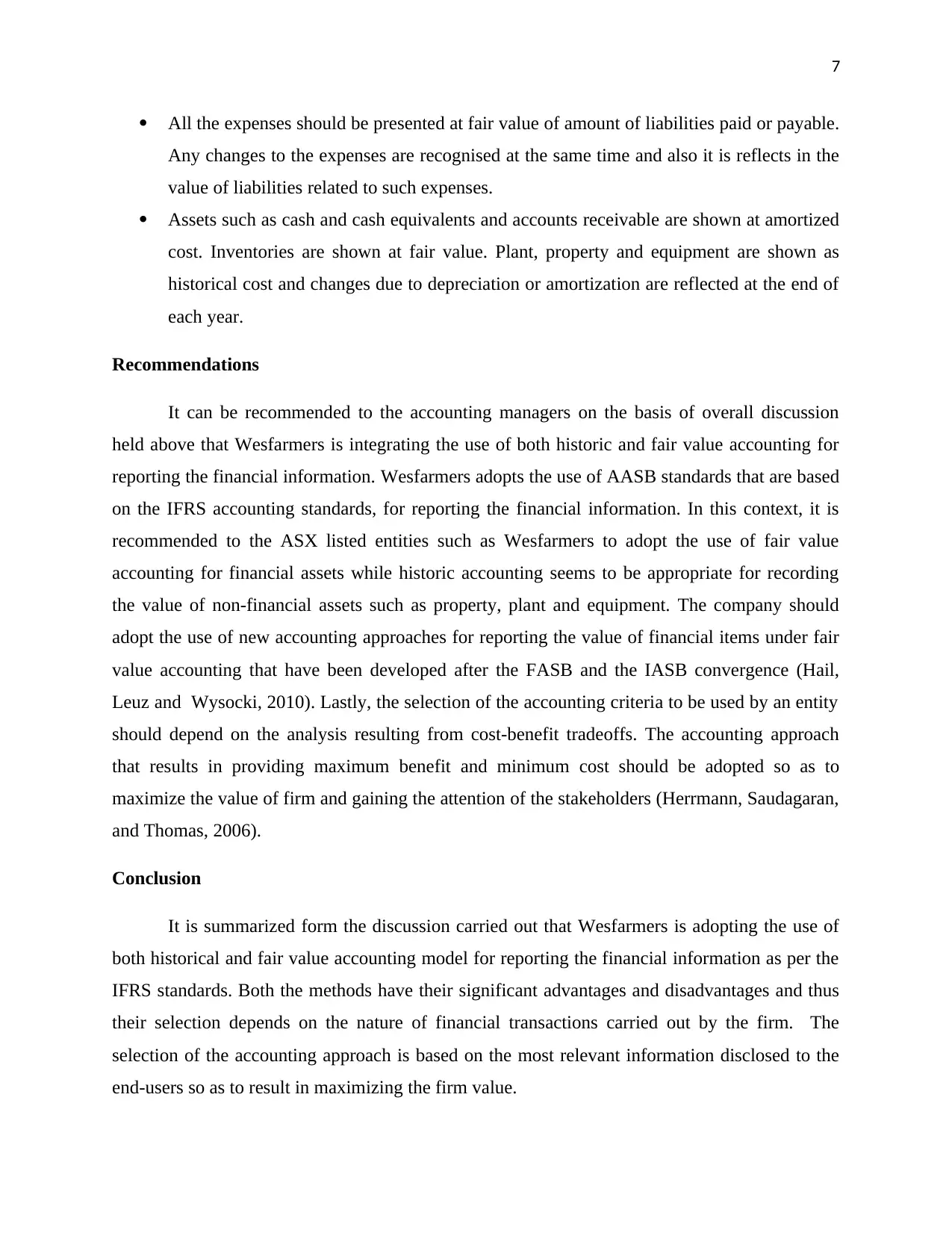
7
All the expenses should be presented at fair value of amount of liabilities paid or payable.
Any changes to the expenses are recognised at the same time and also it is reflects in the
value of liabilities related to such expenses.
Assets such as cash and cash equivalents and accounts receivable are shown at amortized
cost. Inventories are shown at fair value. Plant, property and equipment are shown as
historical cost and changes due to depreciation or amortization are reflected at the end of
each year.
Recommendations
It can be recommended to the accounting managers on the basis of overall discussion
held above that Wesfarmers is integrating the use of both historic and fair value accounting for
reporting the financial information. Wesfarmers adopts the use of AASB standards that are based
on the IFRS accounting standards, for reporting the financial information. In this context, it is
recommended to the ASX listed entities such as Wesfarmers to adopt the use of fair value
accounting for financial assets while historic accounting seems to be appropriate for recording
the value of non-financial assets such as property, plant and equipment. The company should
adopt the use of new accounting approaches for reporting the value of financial items under fair
value accounting that have been developed after the FASB and the IASB convergence (Hail,
Leuz and Wysocki, 2010). Lastly, the selection of the accounting criteria to be used by an entity
should depend on the analysis resulting from cost-benefit tradeoffs. The accounting approach
that results in providing maximum benefit and minimum cost should be adopted so as to
maximize the value of firm and gaining the attention of the stakeholders (Herrmann, Saudagaran,
and Thomas, 2006).
Conclusion
It is summarized form the discussion carried out that Wesfarmers is adopting the use of
both historical and fair value accounting model for reporting the financial information as per the
IFRS standards. Both the methods have their significant advantages and disadvantages and thus
their selection depends on the nature of financial transactions carried out by the firm. The
selection of the accounting approach is based on the most relevant information disclosed to the
end-users so as to result in maximizing the firm value.
All the expenses should be presented at fair value of amount of liabilities paid or payable.
Any changes to the expenses are recognised at the same time and also it is reflects in the
value of liabilities related to such expenses.
Assets such as cash and cash equivalents and accounts receivable are shown at amortized
cost. Inventories are shown at fair value. Plant, property and equipment are shown as
historical cost and changes due to depreciation or amortization are reflected at the end of
each year.
Recommendations
It can be recommended to the accounting managers on the basis of overall discussion
held above that Wesfarmers is integrating the use of both historic and fair value accounting for
reporting the financial information. Wesfarmers adopts the use of AASB standards that are based
on the IFRS accounting standards, for reporting the financial information. In this context, it is
recommended to the ASX listed entities such as Wesfarmers to adopt the use of fair value
accounting for financial assets while historic accounting seems to be appropriate for recording
the value of non-financial assets such as property, plant and equipment. The company should
adopt the use of new accounting approaches for reporting the value of financial items under fair
value accounting that have been developed after the FASB and the IASB convergence (Hail,
Leuz and Wysocki, 2010). Lastly, the selection of the accounting criteria to be used by an entity
should depend on the analysis resulting from cost-benefit tradeoffs. The accounting approach
that results in providing maximum benefit and minimum cost should be adopted so as to
maximize the value of firm and gaining the attention of the stakeholders (Herrmann, Saudagaran,
and Thomas, 2006).
Conclusion
It is summarized form the discussion carried out that Wesfarmers is adopting the use of
both historical and fair value accounting model for reporting the financial information as per the
IFRS standards. Both the methods have their significant advantages and disadvantages and thus
their selection depends on the nature of financial transactions carried out by the firm. The
selection of the accounting approach is based on the most relevant information disclosed to the
end-users so as to result in maximizing the firm value.
Paraphrase This Document
Need a fresh take? Get an instant paraphrase of this document with our AI Paraphraser

8
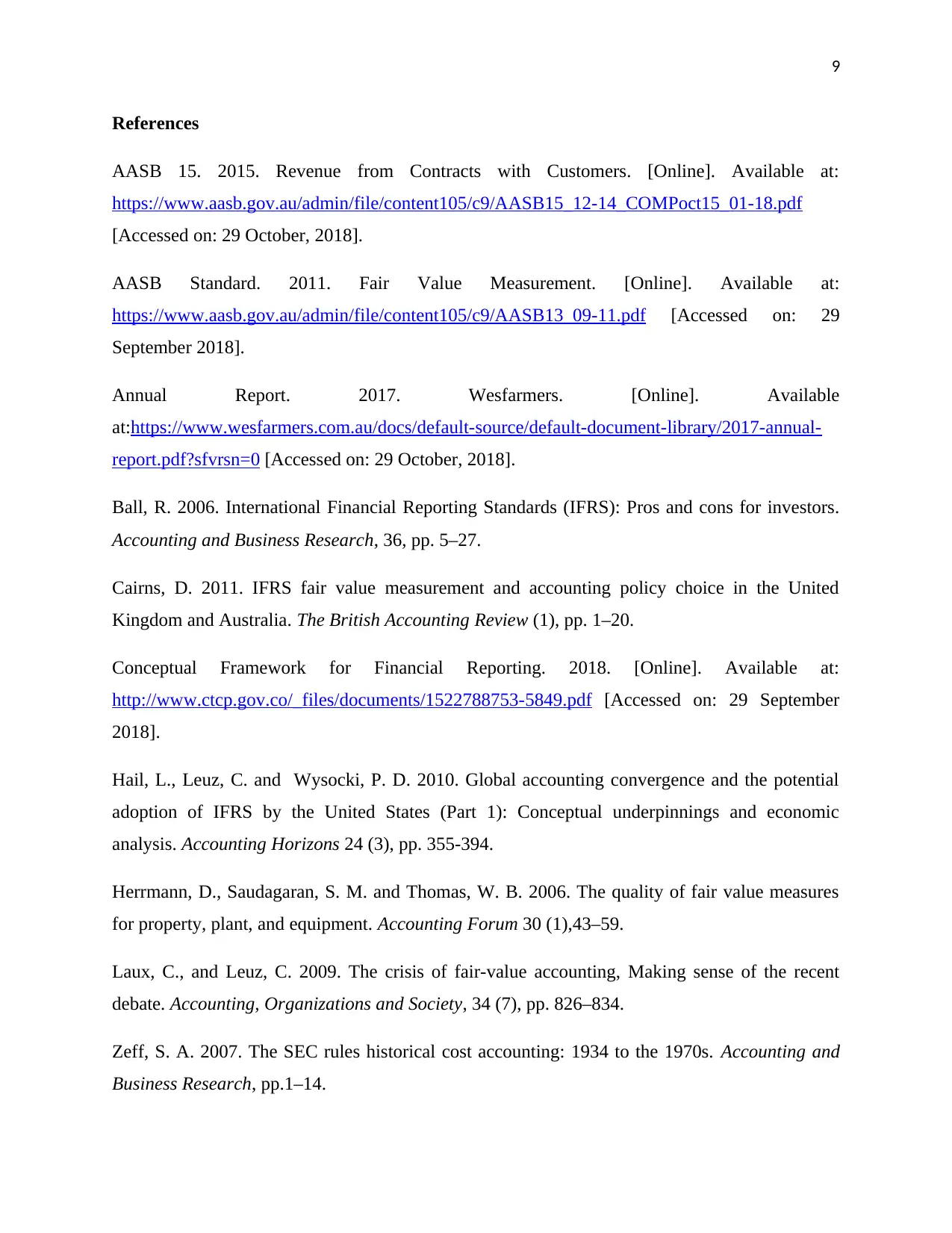
9
References
AASB 15. 2015. Revenue from Contracts with Customers. [Online]. Available at:
https://www.aasb.gov.au/admin/file/content105/c9/AASB15_12-14_COMPoct15_01-18.pdf
[Accessed on: 29 October, 2018].
AASB Standard. 2011. Fair Value Measurement. [Online]. Available at:
https://www.aasb.gov.au/admin/file/content105/c9/AASB13_09-11.pdf [Accessed on: 29
September 2018].
Annual Report. 2017. Wesfarmers. [Online]. Available
at:https://www.wesfarmers.com.au/docs/default-source/default-document-library/2017-annual-
report.pdf?sfvrsn=0 [Accessed on: 29 October, 2018].
Ball, R. 2006. International Financial Reporting Standards (IFRS): Pros and cons for investors.
Accounting and Business Research, 36, pp. 5–27.
Cairns, D. 2011. IFRS fair value measurement and accounting policy choice in the United
Kingdom and Australia. The British Accounting Review (1), pp. 1–20.
Conceptual Framework for Financial Reporting. 2018. [Online]. Available at:
http://www.ctcp.gov.co/_files/documents/1522788753-5849.pdf [Accessed on: 29 September
2018].
Hail, L., Leuz, C. and Wysocki, P. D. 2010. Global accounting convergence and the potential
adoption of IFRS by the United States (Part 1): Conceptual underpinnings and economic
analysis. Accounting Horizons 24 (3), pp. 355-394.
Herrmann, D., Saudagaran, S. M. and Thomas, W. B. 2006. The quality of fair value measures
for property, plant, and equipment. Accounting Forum 30 (1),43–59.
Laux, C., and Leuz, C. 2009. The crisis of fair-value accounting, Making sense of the recent
debate. Accounting, Organizations and Society, 34 (7), pp. 826–834.
Zeff, S. A. 2007. The SEC rules historical cost accounting: 1934 to the 1970s. Accounting and
Business Research, pp.1–14.
References
AASB 15. 2015. Revenue from Contracts with Customers. [Online]. Available at:
https://www.aasb.gov.au/admin/file/content105/c9/AASB15_12-14_COMPoct15_01-18.pdf
[Accessed on: 29 October, 2018].
AASB Standard. 2011. Fair Value Measurement. [Online]. Available at:
https://www.aasb.gov.au/admin/file/content105/c9/AASB13_09-11.pdf [Accessed on: 29
September 2018].
Annual Report. 2017. Wesfarmers. [Online]. Available
at:https://www.wesfarmers.com.au/docs/default-source/default-document-library/2017-annual-
report.pdf?sfvrsn=0 [Accessed on: 29 October, 2018].
Ball, R. 2006. International Financial Reporting Standards (IFRS): Pros and cons for investors.
Accounting and Business Research, 36, pp. 5–27.
Cairns, D. 2011. IFRS fair value measurement and accounting policy choice in the United
Kingdom and Australia. The British Accounting Review (1), pp. 1–20.
Conceptual Framework for Financial Reporting. 2018. [Online]. Available at:
http://www.ctcp.gov.co/_files/documents/1522788753-5849.pdf [Accessed on: 29 September
2018].
Hail, L., Leuz, C. and Wysocki, P. D. 2010. Global accounting convergence and the potential
adoption of IFRS by the United States (Part 1): Conceptual underpinnings and economic
analysis. Accounting Horizons 24 (3), pp. 355-394.
Herrmann, D., Saudagaran, S. M. and Thomas, W. B. 2006. The quality of fair value measures
for property, plant, and equipment. Accounting Forum 30 (1),43–59.
Laux, C., and Leuz, C. 2009. The crisis of fair-value accounting, Making sense of the recent
debate. Accounting, Organizations and Society, 34 (7), pp. 826–834.
Zeff, S. A. 2007. The SEC rules historical cost accounting: 1934 to the 1970s. Accounting and
Business Research, pp.1–14.
⊘ This is a preview!⊘
Do you want full access?
Subscribe today to unlock all pages.

Trusted by 1+ million students worldwide

10
1 out of 10
Related Documents
Your All-in-One AI-Powered Toolkit for Academic Success.
+13062052269
info@desklib.com
Available 24*7 on WhatsApp / Email
![[object Object]](/_next/static/media/star-bottom.7253800d.svg)
Unlock your academic potential
Copyright © 2020–2025 A2Z Services. All Rights Reserved. Developed and managed by ZUCOL.




